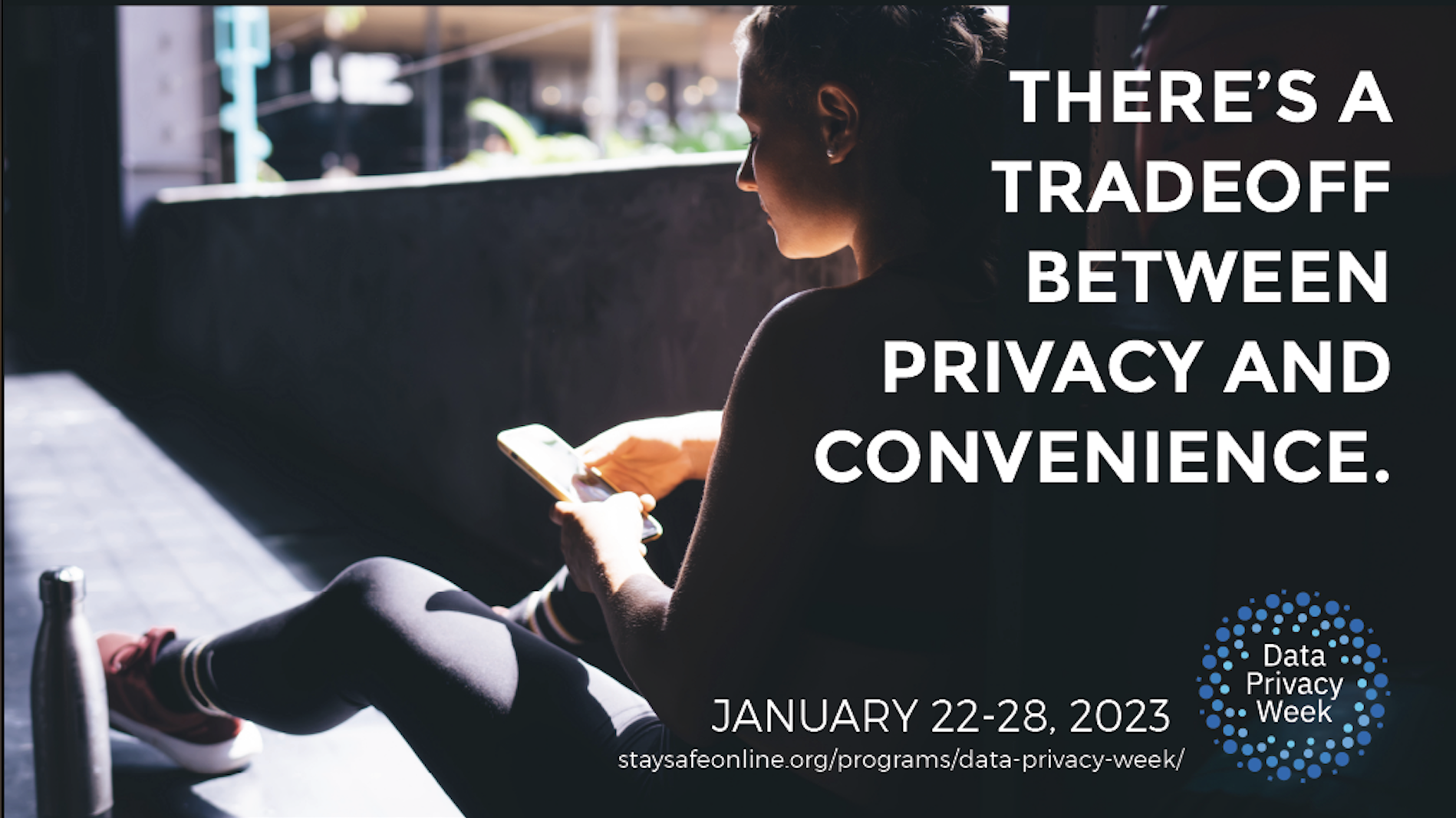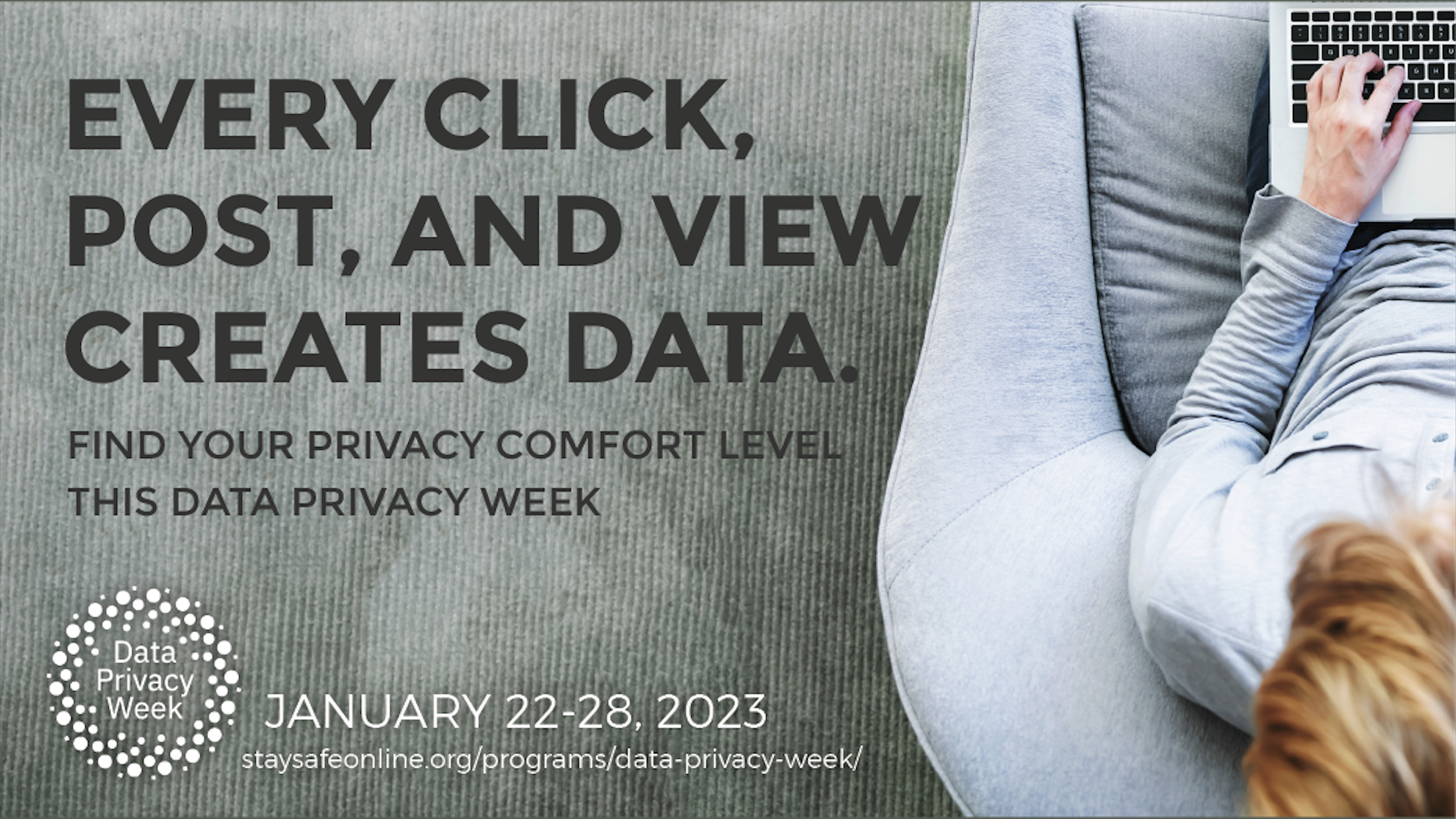Data Privacy Week

Learn about Data Privacy Week -- January 22-28
All Your Online Activity Generates a Trail of Data
Websites, apps, and services collect data on your behaviors, interests, and purchases. Sometimes, this includes personal data, like your Social Security and driver’s license numbers. It can even include data about your physical self, like health data – think about how a smartwatch counts and records how many steps you take.
While it’s true that you cannot control how each byte of data about you and your family is shared and processed, you are not helpless! In many cases, you can control how you share your data with a few simple steps. Remember, your data is precious, and you deserve to be selective about who you share it with!
Here are some simple, easy tips you that will help you manage your data privacy:
 Know the tradeoff between privacy and convenience
Know the tradeoff between privacy and convenience
Nowadays, when you download a new app, open a new online account, or join a new social media platform, you will often be asked for access to your personal information before you can even use it! This data might include your geographic location, contacts, and photos.
For these businesses, this personal information about you is tremendously value — and you should think about if the service you get in return is worth the data you must hand over, even if the service is free.
Make informed decisions about sharing your data with businesses or services:
- Is the service, app, or game worth the amount or type of personal data they want in return?
- Can you control your data privacy and still use the service?
- Is the data requested even relevant for the app or service (that is, “why does a Solitaire game need to know all my contacts”)?
- If you haven’t used an app, service, or account in several months, is it worth keeping around knowing that it might be collecting and sharing your data?
Adjust privacy settings to your comfort level
For every app, account, or device, check the privacy and security settings. These should be easy to find in a Settings section and should take a few moments to change. Set them to your comfort level for personal information sharing; generally, we think it’s wise to lean on the side of sharing less data, not more.
You don’t have to do this for every account at once, start small and over time you’ll make a habit of adjusting all your settings to your comfort. In-depth resources like the NCA's Manage Your Privacy Settings page lets you check the settings of social media accounts, retail stores, apps and more. That said, with so many different settings to manage it can be very challenging to stay on top. However, here are a few important ones to focus on first:
- Geolocation Data: In order to provide more relevant results, many apps will ask for you to share your location data with them. Make sure that you are only sharing this data with apps you trust and that these apps are using your data in a responsible way.
- Contacts Data: Email apps and video conferencing apps virtually all allow for individuals to automatically sync their existing contacts with their services. Therefore, it is important that you share this data only with trusted sources as not only is contact data yours, but it is your friend’s and family’s as well.
- Camera and Photo Data: Social apps universally ask for access to an individual’s photo library and related camera data -- which obviously contains troves of private information. Be sure that only the most trusted sources have access to this information and also double-check settings in the app to filter which photo files apps have access to.
Protect your data
Data privacy and data security go hand-in-hand. Along with managing your data privacy settings, follow some simple cybersecurity tips to keep it safe. The NCA recommends following the Core 4:
- Create long (at least 12 characters), unique passwords for each account and device. A password manager can generate unique, secure passwords for you and store them automatically, so you can easily maintain dozens of passwords securely.
- Turn on multi-factor authentication (MFA) wherever it is permitted – this keeps your data safe even if your password is compromised.
- Turn on automatic device, software, and browser updates, or make sure you install updates as soon as they are available.
- Learn how to identify phishing messages, which can be sent as emails, texts, or direct messages.
79% percent of individuals* said it’s too hard for them to know and understand how companies are using their data. By keeping these few quick tips in mind, individuals can keep much better tabs on their data and create a safer digital environment for themselves to live in.
*Source: CISCO 2022 Consumer Privacy Survey
Campus Privacy Office
UC Resources
Additional Resources
National Cybersecurity Alliance (NCA):
Learn how to protect yourself, your family and your home with the resources and guides the NCA provides, such as:
- Online Safety + Privacy Basics
- Managing Your Privacy Settings
- Infographics
- Privacy Advice from the Experts (YouTube playlist)
Consumer Reports: Consumer Reports shares privacy tips, product ratings and news to help consumers protect their privacy.
Cybersecurity and Infrastructure Security Agency (CISA): CISA leads the effort to enhance the security, resiliency, and reliability of the Nation's cybersecurity and communications infrastructure.
For more information about protecting your security and privacy, visit: security.ucsd.edu and privacy.ucsd.edu
Contact IT Services Security at security@ucsd.edu and the Campus Privacy Office at ucsdprivacy@ucsd.edu

